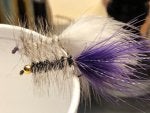Todd, I've tied them all kinds of ways, sparse, dense, big, small, and frankly feel it's a personal choice. I've yet to see that any one way is necessarily better than another. Generally the smaller in size you go, the less dense the marabou, and as you go large, more marabou. Flytire's photo's illustrate sparse & dense very well, but doesn't mean in the same size either or won't work well.
Buggers are a style, and as such can be tied in a variety of ways, and still be productive. So, just because another person likes them one way, doesn't mean how you tied yours was wrong. As has been said here, each person has their thoughts for where & how they fish, so tie them to suit your fishing. Since you are tying your own, vary the amount of marabou and see if it makes any difference.
I like using ostrich herl fibers in some instead of marabou, and of course other fine materials, like fur or hairs can also be used.
One note I will add about the sparse versus dense issue, some fibers can be lost during fishing, so they may get more sparse with use. If you start with them very sparse, and you're hooking up with a lot of fish, you may find no tail left & have to change flies more often.
In the end it's a judgement how much you use.




